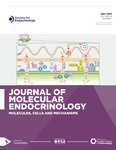Genes involved in human premature ovarian failure
- 1Dipartimento di Scienze Mediche, Università degli Studi di Milano, Milan I-20100, Italy
2Laboratorio di Ricerche Endocrinologiche, IRCCS Istituto Auxologico Italiano, Milan I-20100, Italy
3Unità di Endocrinologia, Fondazione IRCCS Ca' Granda Policlinico, Milan I-20100, Italy
- (Correspondence should be addressed to L Persani who is now at Laboratorio di Ricerche Endocrinologiche, Dipartimento di Scienze Mediche, IRCCS Istituto Auxologico Italiano, Università di Milano, Via Zucchi 18, 20095 Cusano, Milan, Italy; Email: luca.persani{at}unimi.it)
-
Figure 3
Hypothetical scheme of the dominant negative mechanism generated by the original BMP15 mutations described in the two heterozygous sisters affected with ovarian dysgenesis. The recombinant p.Y235C variant was shown to produce aberrant products of high molecular weight by western blot performed in nonreducing conditions. These aberrant products secreted in the follicular fluid microenvironment may impair the paracrine signal of wild-type bioactive dimers by receptor sequestration, thus hampering the formation of dimers between types I and II BMP receptors and consequent generation of intracellular signal leading to the biological effects in target cells, i.e. granulosa cell growth and differentiation.
-
Figure 4
Schematic illustration of the known BMP15 variants that have been detected in POI patients. The specific electropherograms of the variations identified by our group are reported. The different colored boxes show the potential biological mechanisms involved by the variants tested in vitro by Di Pasquale et al. (2004) and Rossetti et al. (2009). The two variants not enclosed in a box did not display any functional defect in vitro and should probably be considered missense variations with modest or no biological effect (Rossetti et al. 2009). The biological impact of the first variation in the mature peptide is presently unknown.
- © 2010 Society for Endocrinology











